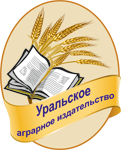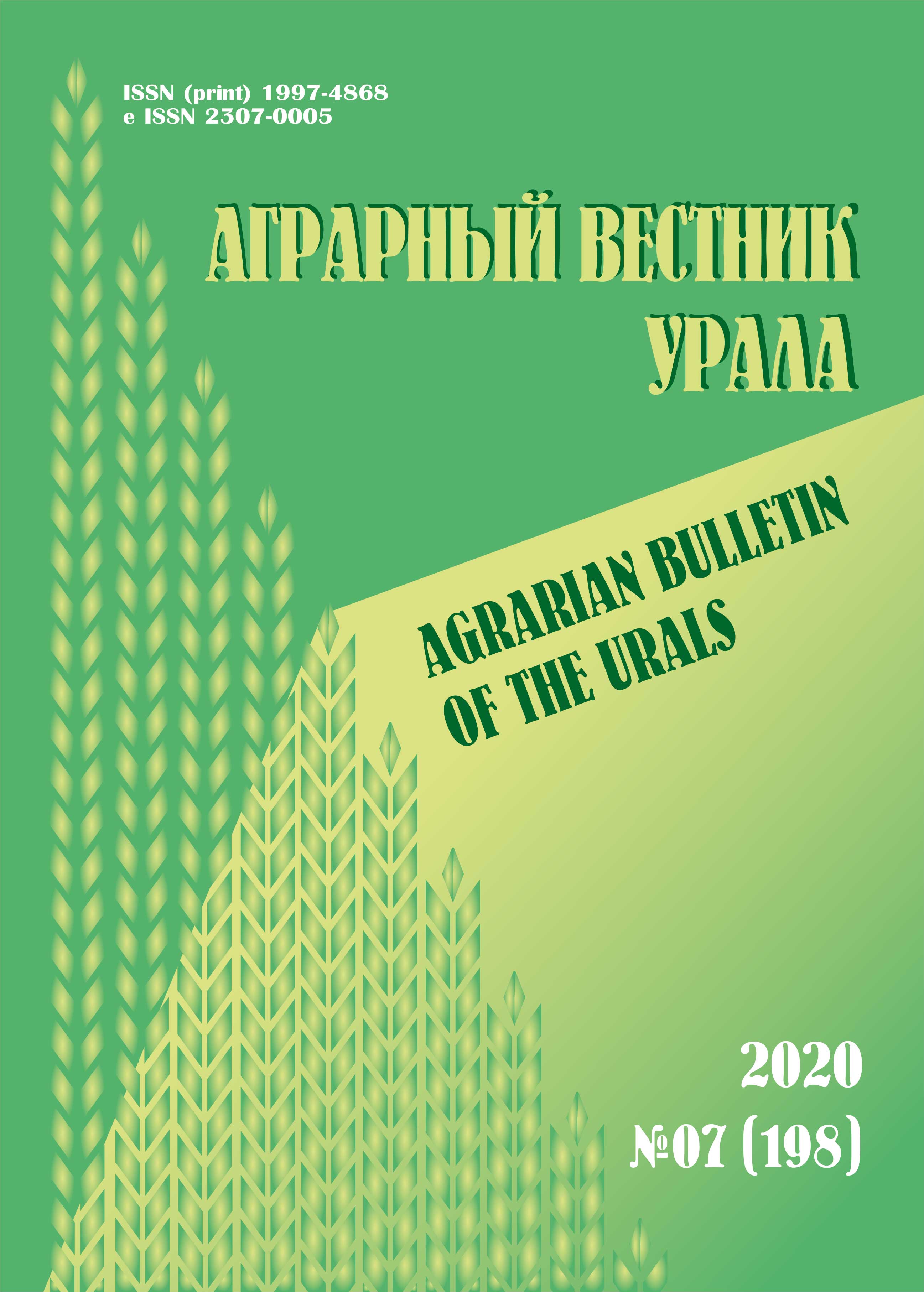Abstract. The results of the study of interspecific black currant hybrids are presented by the method of distant hybridization created in Central Yakutia. Six high-yielding, large-fruited and powdery mildew resistant Altai varieties were crossed with local varieties, which are based on the following currant species – R. dikuscha Fisch. ex Turcz, Ribes pausiflorum Turcz. ex Pojark. and R. procumbens Pall. to develop new adapted varieties. The aim of the research is to evaluate interspecific hybrids of black currant and promising forms to identify for the conditions of Central Yakutia. Objectives are to study the resistance of black currant hybrids to winter damage, powdery mildew and kidney mites; fruitful forms identify; the sources of positive signs and valuable promising forms highlight. Methods. The work was carried out in accordance with the program and methodology of variety study and selection of fruit, berry and nut crops. The hybrids were evaluated in the field against a natural background. Scientific novelty. New sources of economically valuable traits and promising hybrids for black currant breeding in Yakutia will be identified. Results. 13 sources of winter hardiness, 5 - yield were selected as a result of the study of black currant hybrids. A high yield of hybrids immune to powdery mildew was observed in 4 families, and to a kidney mite in 5 families. The selected sources of valuable traits and crossbreeding combinations will be further used in the work on black currants to create a new breeding material. The selected sources of economically valuable traits will be used in the future in the selection of black currants to create a new source material. Two promising forms of black currant distinguished themselves - 1-12-13 (Altayskaya pozdnyaya × Pamyati Kyndyla) and 2-9-13 (Podarok Kuzioru × Khara Kytalyk) according to the complex of features. They are of interest and will be studied for practical breeding.
berry growing, breeding, black currant, interspecific hybrids, winter hardiness, powdery mildew, kidney mite, yield
1. Nigmatzyanov R. A., Sorokopudov V. N. Perspektivy selektsii smorodiny chernoy po kachestvu yagod v usloviyakh Bashkirskogo Predural’ya [Prospects of black currant breeding in terms of berry quality in the conditions of the Bashkir Urals] // Vestnik KrasGAU. 2020. No. 1 (154). Pp. 34-39. (In Russian.) DOI: https://doi.org/10.36718/1819-4036-2020-1-34-39; EDN: https://elibrary.ru/QPPKNV
2. Sazonov F. F. Ispol’zovaniye geneticheskikh resursov v selektsii smorodiny chernoy na ustoychivost’ k patogenam i pochkovomu kleshchu [The use of genetic resources in the selection of black currants for resistance to pathogens and kidney mites] // Fruit and berry growing in Russia. 2016. Vol. 44. Pp. 210-214. (In Russian.) EDN: https://elibrary.ru/VPGEHB
3. Knyazev S.D., Bakhotskaya A.YU. Geneticheskoye raznoobraziye smorodiny chernoy sortov selektsii VNIISPK [Genetic diversity of black currant varieties of VNIISPK selection] // Pomiculture and small fruits culture in Russia. 2018. Vol. 54. Pp. 47-51. (In Russian.) DOI: https://doi.org/10.31676/2073-4948-2018-54-47-51; EDN: https://elibrary.ru/UYYQBO
4. Sorokopudov V. N., Nazaryuk N. I., Makarenko S. A., Sorokopudova O. A. Sibirskiy sad akademika I. P. Kalininoy dlinoyu v zhizn’. Vypusknitsa MSKhA imeni K. A. Timiryazeva na sluzhbe Sibirskogo sadovodstva [Siberian garden of academician I. P. Kalinina for a lifetime. A graduate of the Moscow Agricultural Academy named after K. A. Timiryazev in the service of Siberian horticulture] // Izvestiya Timiryazevskoy sel’skokhozyaystvennoy akademii. 2021. No. 1. Pp. 98-107. (In Russian.) EDN: https://elibrary.ru/BLYGWF
5. Kulikov I. M., Marchenko L. A. Geneticheskiye metody sozdaniya novykh sortov sadovykh rasteniy [Genetic methods for creating new varieties of garden plants] // Vestnik Rossiyskoy akademii nauk. 2017. No. 4. Pp. 358-361. (In Russian.)
6. Kulikov I. M., Evdokimenko S. N., Tumayeva T. A, Kelina A. V., Sazonov F. F., Andronova N. V., Podgayetskiy M. A. Nauchnoye obespecheniye yagodovodstva Rossii I perspektivy yegorazvitiya [Scientific support of berry growing in Russia and prospects for its development] // Vavilov Journal of Genetics and Breeding. 2021. No. 25 (4). Pp. 414-419. (In Russian.) DOI: https://doi.org/10.18699/VJ21.046; EDN: https://elibrary.ru/ASGGAN
7. Sorokopudov V.N., Nazaryuk N.I., Gabysheva N.S. Sovershenstvovaniye sortimenta smorodiny chernoy v Aziatskoy chaste Rossii [Improving the assortment of black currants in the Asian part of Russia] // Bulletin of the Kursk State Agricultural Academy. 2018. No. 7. Pp. 23-28. (In Russian.) EDN: https://elibrary.ru/YNVGBN
8. Korobkova T.S. Otsenka resursnykh vidov yagodnykh rasteniy srednetayezhnoy podzonyYakutii [Assessment of esources peciesof berry plants in the middletaigasubzone of Yakutia] // Eurasian Union of Scientists. 2017. No. 11 (44). Pp. 22-25. (In Russian.) EDN: https://elibrary.ru/YLDKMR
9. Smorodina - NIISS imeni M. A. Lisavenko [Smorodina - Research Institute of Horticulture of Siberia named after M. A. Lisavenko] [e-resource]. URL: http://www.niilisavenko.org/variets/curblack.htm (date of reference: 04.11.2018). (In Russian.)
10. Stepanov A. I., Ivanov R. V., Dayanova G. I., Nikolaeva F. V. Strategicheskie napravleniya innovatsionnogo razvitiya agropromyshlennogo kompleksa Respubliki Sakha (Yakutiya) [Strategic directions of innovative development of the agro-industrial complex of the Republic of Sakha (Yakutia)] // Vestnik of the Far East Branch of the Russian Academy of Sciences. 2019. No. 1 (203). Pp. 5-13. (In Russian.) DOI: https://doi.org/10.25808/08697698.2019.203.1.001; EDN: https://elibrary.ru/LVFIND
11. Filippov D. V., Noyev I. I. Klimaticheskiye osobennosti goroda Yakutska kak faktor pozitivnogo sotsial’no-ekonomicheskogo razvitiya [Climatic features of the city of Yakutsk as a factor of positive socio-economic development] // Nauchnyy elektronnyy zhurnal “Meridian”. 2019. No. 2 (20). Pp. 147-149. (In Russian.)
12. Programma i metodika selektsii plodovykh, yagodnykh I orekhoplodnykh kul'tur [The program and methods of selection of fruit, berry and nut crops]. Orel, 1995. 502 p. (In Russian.)
13. Programma i metodika sortoizucheniya plodovykh, yagodnykh I orekhoplodnykh kul'tur [Program and methodology for the variety study of fruit, berry and nut crops]. Orel, 1999. 608 p. (In Russian.)
14. Tikhonova O. A. Otsenka samoplodnosti sortov chernoy smorodiny v usloviyakh Severo-Zapada Rossii [Evaluation of the self-fertility of black currant varieties in the conditions of the North-West of Russia] // Trudy po prikladnoy botanike, genetike i selektsii. 2019. Vol. 180. No. 2. Pp. 60-72. DOI:https://doi.org/10.30901/2227-8834-2019-2-60-72. (In Russian.) EDN: https://elibrary.ru/MDLNUI
15. Golyaeva O. D., Panfilova O. V., Kalinina O. V. Selektsionnaya otsenka sorta krasnoy smorodiny “Podarok pobeditelyam” i yego inbrednogo potomstva [Plant breeding evaluation of the red currant cultivar “Podarok Pobeditelyam” and its inbred progeny] // Trudy po prikladnoy botanike, genetike i selektsii. 2020. Vol. 181. No. 2. Pp. 35-41. DOI:https://doi.org/10.30901/2227-8834-2020-2-35-41. (In Russian.) EDN: https://elibrary.ru/IRMXXD
16. Zhidekhina T. V., Gur’yeva I. V. Sozdaniye vysokoustoychivogo k sferoteke gibridnogo fonda chernoy smorodiny s ispol’zovaniyem sortoobraztsov orlovskoy selektsii [Creating a highly resilientto the spherotek of the hybrid fund of black currant using varieties of the Oryol selection] // Selektsiya i sortorazvedeniye sadovykh kul’tur. 2020. No. 7 (1-2). Pp. 73-79. DOI:https://doi.org/10.24411/2500-0454-2020-11219. (In Russian.) EDN: https://elibrary.ru/JPEEPQ
17. Stepanova N. A. Osobennosti razvitiya i vredonosnosti pochkovogo kleshcha na smorodine [Features of the development and harmfulness of the kidney mite on currants] // Bulletin of agrarian science. 2018. No. 3 (72). Pp. 139-145. DOI:https://doi.org/10.15217/48484. (In Russian.) DOI: https://doi.org/10.15217/issn2587-666X.2018.3.139; EDN: https://elibrary.ru/XTASPZ
18. Tikhonova O. A. Sorta chernoy smorodiny selektsii VNIISPK na Severo-Zapade Rossii [Varieties of black currant selection of All-Russian Research Institute of Fruit Crops Breeding in the North-West of Russia] // Sovremennoye sadovodstvo - Contemporary horticulture. 2019. No. 4. Pp. 76-91. DOI:https://doi.org/10.24411/2312-6701-2019-10408. (In Russian.) EDN: https://elibrary.ru/YHDKWK
19. Zaritskiy A. V., Kovaleva V. V. Potentsial’naya i fakticheskaya produktivnost’ novykh gibridov chernoy smorodiny selektsii Dal’nevostochnogo GAU [Potential and actual productivity of new blackcurrant hybrids bred by the Far Eastern State Agrarian University] // Vestnik NSAU. 2018. No. 3 (48). Pp. 17-22. DOI:https://doi.org/10.31677/2072-6724-2018-48-3-17-22. (In Russian.) EDN: https://elibrary.ru/YLRFAL









